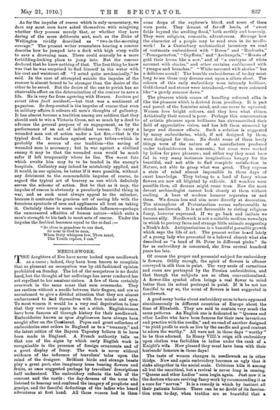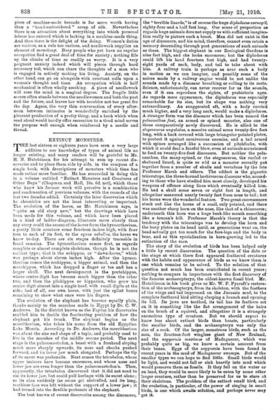NEEDLEWORK.
THE daughters of Eve have never looked upon needlework as a curse ; indeed, they have been known to complain that so pleasant an occupation was by old-fashioned opinion prohibited on Sunday. The lot of the sempstress is no doubt hard, but the thought of her sufferings has never rendered her art repellent to her amateur sisters. A few of them certainly overwork in the same sense that men oversmoke. They are restless without a needle between their fingers, and are so accustomed to give a divided attention that they are almost embarrassed to find themselves with free minds and eyes. To most women it would be a very real deprivation to hear that they were never again to set a stitch. Englishwomen have been famous all through history for their needlework. Embroideries known as opus Anglicanunt have always been sought after on the Continent. Popes and great collectors of embroideries sent orders to England as to a "treasury," and the latest critics of the Bayeux Tapestry believe it to have been made in England. A French authority tells us that one of the signs by which early English work is recognisable- is the presence of foreign ornaments and of a great display of fancy. The work is never without evidence of the influence of travellers' tales upon the mind of the designer. Brilliant birds and strange beasts play a great part, also imaginary trees bearing flowers and fruits, at once suggested perhaps by travellers' descriptions half understood. The embroidery reflects the talk of the convent and the castle : the day-dreams of the nuns who listened to hearsay and confused the imagery of prophets and gossips, and the fanciful deductions of the ladles who heard adventures at first hand, All these women had in them some drops of the explorer's blood, and some of them were poets. They dreamt of far-off land; of " sweet fields beyond the swelling flood," both earthly and heavenly. They were religious, romantic, adventurous. Strange how the character of a people may be read even in its needle- work ! In a Canterbury ecclesiastical inventory we read of vestments embroidered with " Roses" and "Roebucks," " Pomegarnettes," " Gryffons," and "Archangels," "Beasts of gold their horns like a saw," and of "a curteyne of white sarcenet with stories," and other curtains emblazoned with " ymages and branches." "White sarcenet with stories " has a delicious sound ! The humble embroideress of to-day must long to see those rosy dreams cast upon a silken sheet. The colours of this early embroidery were intensely brilliant. Gold-thread and stones were introduced,—they were coloured like " a gawdy summer dawn."
The pleasure which comes of handling coloured silks is like the pleasure which is derived from jewellery. It is part and parcel of the feminine mind, and can never be uprooted. Women love bright colours, and they love what shines. Artistically their record is poor. Perhaps this concentration of artistic pleasure upon brilliance has circumscribed their field of appreciative vision, and has left them unmoved by larger and dimmer effects. Such a solution is suggested by many embroideries, which, if not designed by them, were designed for them. No doubt some of these lovely things were of the nature of a manufacture produced under taskmistresses in convents; but some were worked by ladies for pure pleasure ; and either way they must have fed in very many instances imaginations hungry for the beautiful, and not able to find complete satisfaction in Nature, not able to grasp what was great. They express a state of mind almost impossible in these days of exact knowledge. They belong to a land of fancy whose flowers are now all blighted by ridicule. All wonders were possible then, all dreams might come true. Now the most devout archaeologist cannot look closely at them without smiling. A haze of modern humour separates us and them. We dream less and aim more directly at decoration. The atmosphere of Protestantism seems unfavourable to church needlework. It is not favourable to rioting religious fancy, however expressed. If we go back and imitate we become silly. Needlework is not a suitable medium nowadays in which to portray faces and strange little animals suggesting a Noah's Ark. Antiquarianism is a beautiful parasitic growth which saps the life of art. The present writer heard lately of a young lady who presented to a beloved church what she described as "a head of St. Peter in different pinks." So far as embroidery is concerned, she lives several hundred years too late.
Of course the proper and perennial subject for embroidery is flowers. Oddly enough, the spirit of flowers is oftener conveyed in silk than in paint. The very souls of carnations and roses are portrayed by the Persian embroideries, and that though the subjects are so often conventionalised. A flower-like symbol often brings a real flower to mind better than its actual portrayal in paint. If it be not too fanciful to say so, the scent of flowers is best suggested in needlework.
A good many books about embroidery seem to have appeared simultaneously in different countries of Europe about the time of Elizabeth. They are said to contain very much the same patterns. An English one is dedicated to " Queens and other Ladies who have been famous for their rare inventions and practice with the needle," and we read of another designed "to yield profit to such as live by the needle and good content to adorn the worthy." All were not in those days " worthy " to be thus adorned. In Henry reign silk embroidery upon clothes was forbidden to ladies under the rank of a Knight's wife. How pleased they must have been with their husbands' honours in those days I
The taste of women changes in needlework as in other thintm. Now and again embroidery becomes so ugly that it sinks altogether in the social scale. Criticism kills it among all but the uncritical, but a revival is never long in coming. " Queens and other Ladies " soon begin again. Just now it is the doctors who are reviving fancy work by recommending it as a cure for "nerves." It is a remedy in which by instinct all their patients believe. There can be no doubt of its fascina- tion even to-day, when textiles are so beautiful that a
piece of machine-made brocade is far more worth having than a " hand-embroidered " scrap of silk. Nevertheless there is an attraction about everything into which personal labour has entered which is lacking in a machine-made thing. And then there is the delight of the doing. Women's duties are various, as a rule too various, and needlework supplies an element of monotony. Busy people who yet have no regular occupation find a great deal of time for anxiety; nothing fills up the chinks of time so readily as worry. It is a very poignant anxiety indeed which will pierce through hard necessary toil, which can share the thoughts of a man who is engaged in actively making his living. Anxiety, on the other hand, can go on alongside with constant calls upon a woman's thought and time. An occupation which is half mechanical is often wholly soothing. A piece of needlework will ease the mind in a magical degree. The fragile little screen often stands between the needlewoman and both the past and the future, and leaves her with troubles not too great for the day. Again, the very thin conversation of every after- noon between intimates is wonderfully enriched by the pleasant production of a pretty thing, and a. book which when read aloud would hardly offer recreation to a tired mind serves the purpose well enough when reinforced by a needle and thread.







































 Previous page
Previous page